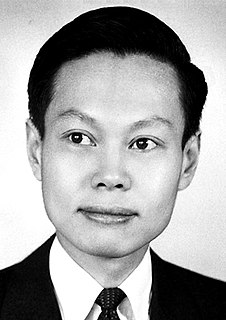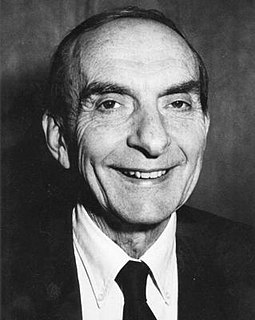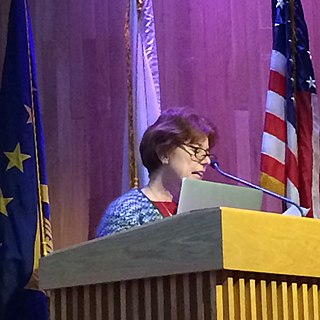Related Research Articles
The American Physical Society (APS) is a not-for-profit membership organization of professionals in physics and related disciplines, comprising nearly fifty divisions, sections, and other units. Its mission is the advancement and diffusion of knowledge of physics. The society publishes more than a dozen scientific journals, including the prestigious Physical Review and Physical Review Letters, and organizes more than twenty science meetings each year. APS is a member society of the American Institute of Physics. Since January 2020 the organization is led by chief executive officer Jonathan Bagger.

Yang Chen-Ning or Chen-Ning Yang, also known as C. N. Yang or by the English name Frank Yang, is a Chinese theoretical physicist who made significant contributions to statistical mechanics, integrable systems, gauge theory, and both particle physics and condensed matter physics. He and Tsung-Dao Lee received the 1957 Nobel Prize in Physics for their work on parity nonconservation of weak interaction. The two proposed that one of the basic quantum-mechanics laws, the conservation of parity, is violated in the so-called weak nuclear reactions, those nuclear processes that result in the emission of beta or alpha particles. Yang is also well known for his collaboration with Robert Mills in developing non-abelian gauge theory, widely known as the Yang–Mills theory.

Edward Mills Purcell was an American physicist who shared the 1952 Nobel Prize for Physics for his independent discovery of nuclear magnetic resonance in liquids and in solids. Nuclear magnetic resonance (NMR) has become widely used to study the molecular structure of pure materials and the composition of mixtures. Friends and colleagues knew him as Ed Purcell.
Physical Review is a peer-reviewed scientific journal established in 1893 by Edward Nichols. It publishes original research as well as scientific and literature reviews on all aspects of physics. It is published by the American Physical Society (APS). The journal is in its third series, and is split in several sub-journals each covering a particular field of physics. It has a sister journal, Physical Review Letters, which publishes shorter articles of broader interest.

David Norman Schramm was an American astrophysicist and educator, and one of the world's foremost experts on the Big Bang theory. Schramm was a pioneer in establishing particle astrophysics as a vibrant research field. He was particularly well known for the study of Big Bang nucleosynthesis and its use as a probe of dark matter and of neutrinos. He also made important contributions to the study of cosmic rays, supernova explosions, heavy-element nucleosynthesis, and nuclear astrophysics generally.
Christoph Carl Herbert "Chris" Adami is a professor of Microbiology and Molecular Genetics, as well as professor of Physics and Astronomy, at Michigan State University.
Peter van Nieuwenhuizen is a Dutch physicist. He is now a distinguished Professor at Stony Brook University in the United States. Van Nieuwenhuizen is best known for his discovery of supergravity with Sergio Ferrara and Daniel Z. Freedman.

Ashok Das is an Indian American theoretical physicist, an author and award-winning teacher of Physics. He is professor of physics at University of Rochester and Adjunct professor of Physics at Saha Institute of Nuclear Physics, Kolkata, India and Institute of Physics, Bhubaneswar, Bhubaneswar, India.
Alexander Borisovich Zamolodchikov is a Russian physicist, known for his contributions to condensed matter physics, two-dimensional conformal field theory, and string theory, and is currently the C.N. Yang/Wei Deng Endowed Chair of Physics at Stony Brook University.
IOP Publishing is the publishing company of the Institute of Physics. It provides publications through which scientific research is distributed worldwide, including journals, community websites, magazines, conference proceedings and books. The Institute of Physics is a scientific charity devoted to increasing the practice, understanding and application of physics. Any financial surplus earned by IOP Publishing goes to support physics through the activities of the Institute.

Gerald Edward Brown was an American theoretical physicist who worked on nuclear physics and astrophysics. Since 1968 he had been a professor at the Stony Brook University. He was a distinguished professor emeritus of the C. N. Yang Institute for Theoretical Physics at Stony Brook University.
George H. Miley is a professor emeritus of physics from the University of Illinois at Urbana–Champaign. Miley is a Guggenheim Fellow and Fellow of the American Nuclear Society, the American Physical Society and the Institute of Electrical and Electronics Engineers. He was Senior NATO Fellow from 1994 to 1995, received the Edward Teller Medal in 1995, the IEEE Nuclear and Plasma Science Award in Fusion Technology in 2003 and the Radiation Science and Technology Award in 2004. He holds several patents.
Gail Catherine McLaughlin is an American nuclear astrophysicist specializing in astrophysical neutrinos and the r-process for nucleosynthesis. She is Distinguished University Professor of Physics at North Carolina State University.

Barbara Jacak is a nuclear physicist who uses heavy ion collisions for fundamental studies of hot, dense nuclear matter. She is Director of the Nuclear Science Division, Lawrence Berkeley National Laboratory, and a professor of Physics at UC Berkeley. Before going to Berkeley, she was a member of the Department of Physics and Astronomy at Stony Brook University, where she held the rank of Distinguished Professor. She is a leading member of the collaboration that built and operates the PHENIX detector, one of the large detectors that operated at the Relativistic Heavy Ion Collider at Brookhaven National Laboratory, and was involved in the discovery of the quark gluon plasma and its strongly coupled, liquid-like behavior. Throughout her career she has served on many advisory committees and boards including the National Research Council Committee on Nuclear Physics, and the Physical Review C Editorial Board.

Philip H. Bucksbaum is an American atomic physicist, the Marguerite Blake Wilbur Professor in Natural Science in the Departments of Physics, Applied Physics, and Photon Science at Stanford University and the SLAC National Accelerator Laboratory. He also directs the Stanford PULSE Institute.
James Lattimer is a nuclear astrophysicist who works on the dense nuclear matter equation of state and neutron stars.
Dmitri E. Kharzeev is an American theoretical physicist most notable for his work on the chiral magnetic effect.
John D. Lindl is an American physicist who specializes in inertial confinement fusion (ICF). He is currently the Chief Scientist of the National Ignition Facility at the Lawrence Livermore National Laboratory.
Jolie Antonia Cizewski is an American nuclear physicist known for her work on high-mass nuclei, including their symmetries, superdeformation, magic numbers, and the r-process. She is a distinguished professor of physics at Rutgers University.
Maria Victoria (Marivi) Fernández-Serra is a Spanish condensed matter physicist known for her research applying density functional theory to the structure and dynamics of water. Other topics in her research include supercomputer simulations of the quantum-mechanical behavior of liquid-metal interfaces, the design of semiconductor-based nanowires, and the development of sensors for detecting dark matter. She is a professor of physics and astronomy at Stony Brook University.